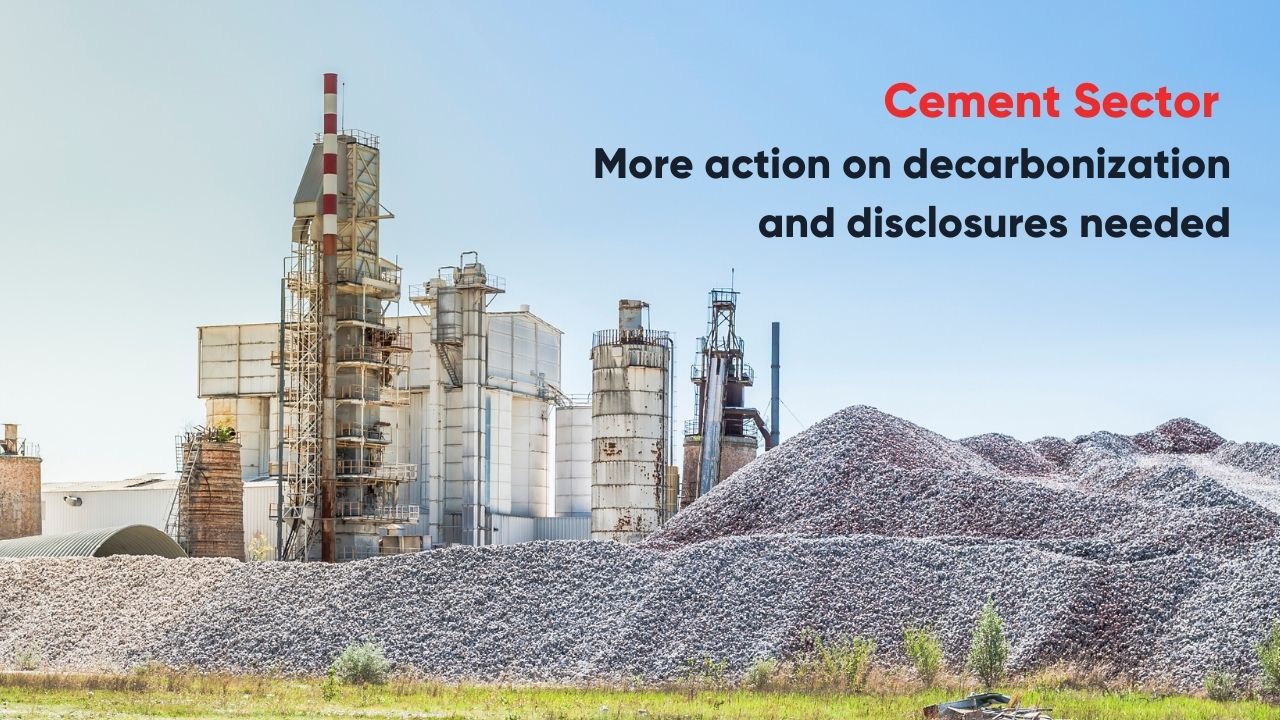Maybank KimEng assessed the ESG strategy and disclosures of 15 Indian cement cos.

Cement is one of the top three Co2 emitters globally and is critical to the overall decarbonization and alignment of temperature to less than 2˚C increase by 2050 as targeted by the Paris Agreement.
Based on the analysis
a) the top 5 cement companies are better prepared for climate change,
b) companies are still in an expansion mode and capital allocation for decarbonization is low and
c) disclosures are better than other sectors but need a lot of improvement and consistency.
Good ESG adoption but big improvement is distant
Indian cement industry averaged 576 kgCo2/T vs global average of 654 in 2018. In particular, the top five companies ACC, Ambuja Cements, Ultratech, Shree Cement and Dalmia Bharat are in the lead across several key ESG parameters and target setting/commitments.
However, the concerns are
a) lack of standardized information on ESG by many of the 15 companies we assessed
b) lack of commitment on going carbon neutral/net zero barring 5-6 companies and
c) lack of articulation of strategy to overcome water stress and biodiversity risk.
The assessment of the public disclosures of the 15 companies suggests that Holcim Group owned ACC and Ambuja Cements have some of the best in-depth disclosures on environment, biodiversity, human capital, community service, governance practices and energy management.
In terms of the target setting for the future, Ultratech is ahead because of its pledge on net zero using the SBTi approach, internal carbon pricing and reduction in specific energy/emission intensity by 2032. It is the only company to commit to TCFD reporting besides the Holcim owned ACC and Ambuja Cement.
Cement sector de-carbonization is challenging
India is the world’s 2nd largest cement producer with more than half a billion tonnes of cement capacity. Its per capita cement consumption at 225kg is less than half of the global average and given the estimated urbanization of over 50% in the next two decades, the cement capacity and consumption in India are likely to expand further. The emissions from cement production would only increase over the next 1-1.5 decades but its intensity can be reduced. The Indian cement sector generates 210mt Co2 pa, 10% of the world’s cement industry Co2 emission. On the whole, the cement sector forms 7% of the global Co2 emissions pa. The Indian cement sector is doing better in terms of emission reduction than the global average. Its Co2 emissions were at 580kg/T in 2018, a 28% decline vs its baseline in 1990. The global average Co2 emission was at 637kg/T in 2018, down 16% vs its baseline in 1990.
What are cement emissions and how do they arise?
Cement is an energy intensive industry and is the third largest consumer of coal after the power and steel sector. It requires both electrical and thermal energy for its operations. In India, cement sector consumes c. 10% of the coal and 6% of the electricity of the Indian industrial sector. On average, cement plants spend 35-50% of their manufacturing cost on energy.
The kiln process consumes nearly 90% of the cement manufacturing energy and the balance is consumed by fuel and raw materials preparation, grinding of clinker and blending of materials to prepare the finished cement product.
Modern cement plants consume 78kwh/T of cement production. This is required for the kiln, coal and cement mill operations and is used by fans, conveyors, packers and lighting systems. Kiln and Mills use 60% of the electrical energy of a cement plant. In case of older cement plants this energy consumption may range 80-100 kwh/T.
Coal and petroleum coke are mostly used as primary fuel to burn raw mix. Liquid petroleum such as diesel are used in starting up the kiln. On average, an Indian cement plant requires 726kcal/kg of thermal energy for 1kg of clinker. The major use of thermal energy is in the kiln and pre-calciner systems. The most energy concentrated stage in cement production is ‘pyro processing’ or conversion of raw meal to clinker. The specific energy consumption of the Indian cement plants is falling due to the continuous upgrading of technologies and the change in process technologies.
Of the above emissions, 57% are due to Co2 from the calcination process which releases Co2 and the balance is from use of energy. These are part of the Scope1 September 9, 2021 7 India Cement Sector and 2 of the GHG emissions arising from cement manufacturing within the unit where production takes place. The scope 1 emissions pertain to the energy produced and consumed within the plant and scope 2 refers to purchased energy consumed within the plant/offices. The Scope 3 emissions are over and above the manufacturing process and arises from the customers and suppliers of the company. While most cement companies report their Scope 1-2 emissions, few of them report their Scope 3 emissions too. The scope 3 emissions are typically 15- 17% of the total emissions.

